
The Gallipoli peninsula is located in the southern part of East Thrace, the European part of Turkey, with the Aegean Sea to the west and the Dardanelles strait to the east.

Anzac Day is a national day of remembrance in Australia and New Zealand that broadly commemorates all Australians and New Zealanders "who served and died in all wars, conflicts, and peacekeeping operations" and "the contribution and suffering of all those who have served". Observed on 25 April each year, Anzac Day was originally devised to honour the members of the Australian and New Zealand Army Corps (ANZAC) who served in the Gallipoli campaign, their first engagement in the First World War (1914–1918).

The Gallipoli campaign, the Dardanelles campaign, the Defense of Gallipoli or the Battle of Gallipoli was a military campaign in the First World War on the Gallipoli peninsula from 19 February 1915 to 9 January 1916. The Entente powers, Britain, France and the Russian Empire, sought to weaken the Ottoman Empire, one of the Central Powers, by taking control of the Ottoman straits. This would expose the Ottoman capital at Constantinople to bombardment by Allied battleships and cut it off from the Asian part of the empire. With Turkey defeated, the Suez Canal would be safe and a year-round Allied supply route could be opened through the Black Sea to warm-water ports in Russia.

The Battle of Lone Pine was fought between Australian and New Zealand Army Corps (ANZAC) and Ottoman Empire forces during the Gallipoli Campaign of the First World War, between 6 and 10 August 1915. The battle was part of a diversionary attack to draw Ottoman attention away from the main assaults being conducted by British, Indian and New Zealand troops around Sari Bair, Chunuk Bair and Hill 971, which became known as the August Offensive.

The landing at Anzac Cove on Sunday, 25 April 1915, also known as the landing at Gaba Tepe and, to the Turks, as the Arıburnu Battle, was part of the amphibious invasion of the Gallipoli Peninsula by the forces of the British Empire, which began the land phase of the Gallipoli Campaign of the First World War.
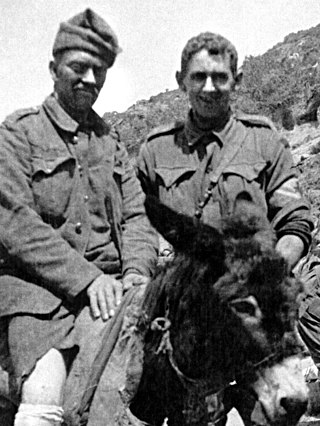
John Kirkpatrick, commonly known as John Simpson, was a stretcher bearer with the 3rd Australian Field Ambulance during the Gallipoli campaign – the Allied attempt to capture Constantinople, capital of the Ottoman Empire, during the First World War.
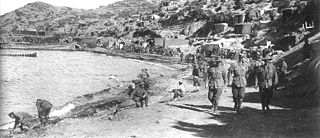
Anzac Cove is a small cove on the Gallipoli peninsula in Turkey. It became famous as the site of World War I landing of the ANZACs on 25 April 1915. The cove is 600 metres (2,000 ft) long, bounded by the headlands of Arıburnu to the north and Little Arıburnu, known as Hell Spit, to the south. Following the landing at Anzac Cove, the beach became the main base for the Australian and New Zealand troops for the eight months of the Gallipoli campaign.

Cape Helles is the rocky headland at the southwesternmost tip of the Gallipoli peninsula, Turkey. It was the scene of heavy fighting between Ottoman Turkish and British troops during the landing at Cape Helles at the beginning of the Gallipoli campaign in 1915. The name derives from the Greek Helle; Helles means "Helle's" in Greek.

The Lone Pine was a solitary tree on the Gallipoli Peninsula in Turkey, which marked the site of the Battle of Lone Pine in August 1915. It was a Turkish or East Mediterranean pine.
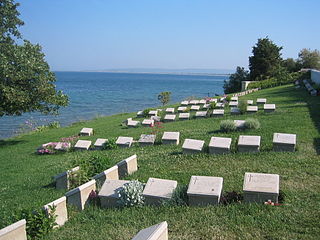
Beach Cemetery is a small Commonwealth War Graves Commission cemetery containing the remains of allied troops who died during the Battle of Gallipoli. It is located at Hell Spit, at the southern end of Anzac Cove on the Gallipoli Peninsula.

Shrapnel Valley Cemetery is a cemetery from World War I and is the second largest Commonwealth War Graves Commission Cemetery in the former Anzac sector of the Gallipoli Peninsula, Turkey, after Lone Pine Cemetery.

Quinn's Post Cemetery is a Commonwealth War Graves Commission cemetery from World War I in the former Anzac sector of the Gallipoli Peninsula, Turkey. The battles at Gallipoli, some of whose participating soldiers are buried at this cemetery, were an eight-month campaign fought by Commonwealth and French forces against Turkish forces in an attempt to force Turkey out of the war, to relieve the deadlock of the Western Front (France/Belgium) and to open a supply route to Russia through the Dardanelles and the Black Sea.
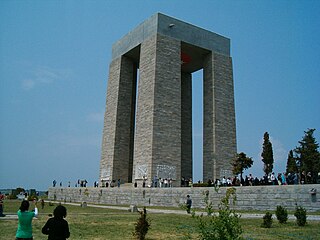
The Çanakkale Martyrs' Memorial is a war memorial commemorating the service of about 253,000 Turkish soldiers who participated at the Battle of Gallipoli, which took place from April 1915 to December 1915 during the First World War. It is located within the Gallipoli Peninsula Historical National Park on Hisarlık Hill in Morto Bay at the southern end of the Gallipoli peninsula in Çanakkale Province, Turkey.
Shell Green Cemetery is a Commonwealth War Graves Commission Cemetery from World War I in the former Anzac sector of the Gallipoli Peninsula, Turkey for soldiers killed during the Gallipoli campaign. The eight-month campaign was fought by Commonwealth and French forces against Turkish forces in an attempt to force Turkey out of the war, to relieve the deadlock of the Western Front (France/Belgium) and to open a supply route to Russia through the Dardanelles and the Black Sea.

Plugge's Plateau Cemetery is the smallest Commonwealth War Graves Commission cemetery on the Gallipoli Peninsula in Turkey. It contains some of soldiers killed during World War I during the battles at Gallipoli, was an eight-month campaign fought by Commonwealth and French forces against Turkish forces in an attempt to force Turkey out of the war, to relieve the deadlock of the Western Front (France/Belgium) and to open a supply route to Russia through the Dardanelles and the Black Sea.
There are approximately 12,000 Australians in Turkey. Of these, the overwhelming majority are in the capital Ankara, and the remainder are mostly in Istanbul. Australian expatriates in Turkey form one of the largest overseas Australian groups in Europe and Asia. The vast majority of Australian nationals in Turkey are Turkish Australians.
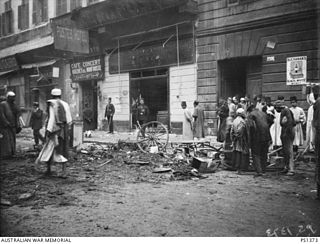
The Battle of the Wazzir was the name given to several riots of Australian, British and New Zealand troops in Cairo, Egypt, during World War I. The main incident occurred on 2 April 1915, but a smaller incident also took place on 31 July that year. In the aftermath of the war, another incident took place in February 1919.

The third attack on Anzac Cove was an engagement during the Gallipoli Campaign of the First World War. The attack was conducted by the forces of the Ottoman Turkish Empire, against the forces of the British Empire defending the cove.
Gelibolu War Museum is a museum in Gelibolu, Turkey.

The Gallipoli Peninsula Historical Site covers over 33,000 hectares in Gallipoli, Turkey. The park was established in 1973 by the Turkish government and is included in the United Nations list of National Parks and Protected Areas. Gallipoli Peninsula Historical Site is home to memorials, graveyards, and commemorations of events that took place on the peninsula since the First World War.


















